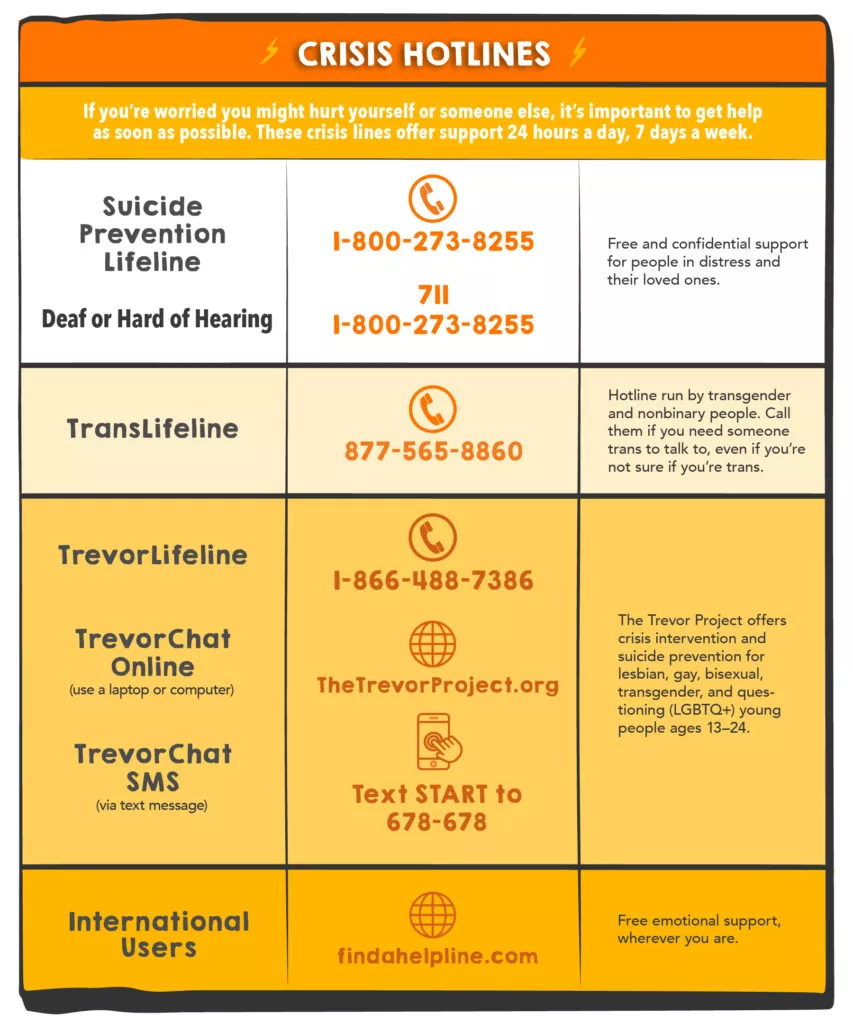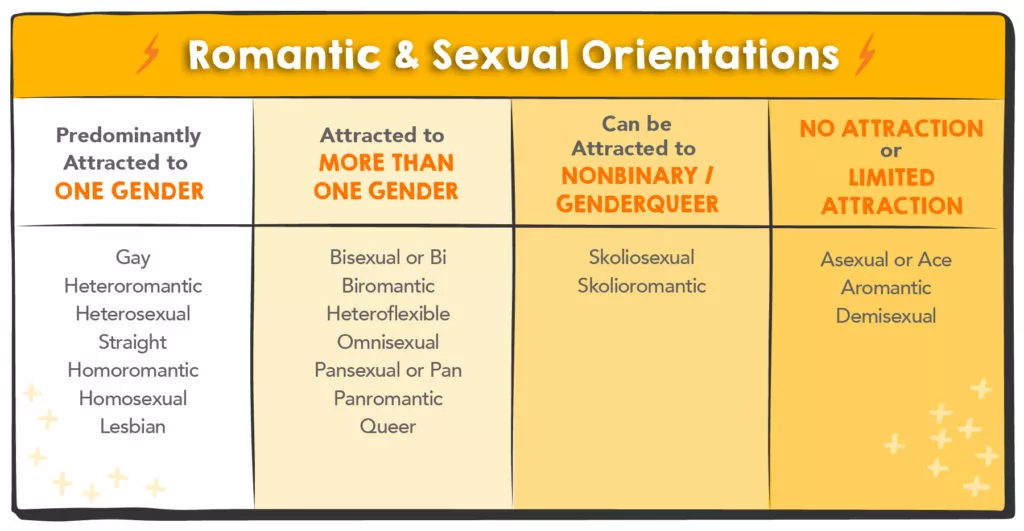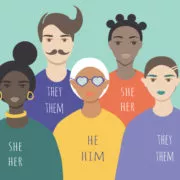During our adolescent years, we grow, change, and discover who we are. We develop our own identities and figure out our personal ideas and values — which may or may not match the ones we were raised with. Part of this process includes exploring our sexual and romantic orientations: who we are physically and emotionally attracted to.
This time of growth and discovery can be challenging. It can be frustrating to have so many questions about who you are, and so few answers. Depending on your family, friends, and community, you might not feel safe to explore different identities or express who you are inside.
But you don’t have to figure this all out by yourself. There are many people who will be happy to offer you support and advice on this journey. Here’s a guide to help you find your way.
#1 – Know that questioning your orientation is normal

It’s completely normal to have sexual and romantic thoughts during puberty — about people of any gender. Many of us go through a period of questioning who we’re attracted to, even if we don’t tell anyone about it.
We all need time to find out what our orientation is, no matter if we’re straight, gay, or something else. Some of us find that who we are attracted to changes over time, and some of us realize we are not interested in sex or romance at all.
No matter your orientation — or your questions about it — know that you are wonderful just as you are!
#2 – Ask yourself some questions
Try journaling or spending some quiet time alone thinking about these questions.
- Have you felt a strong sexual or romantic attraction to anyone?
- Who do you have crushes on or fantasies about?
- If you imagine yourself in a relationship, who do you picture yourself with?
- Do you have strong feelings about the gender of people you’re sexually or romantically involved with?
- If you’ve had romantic or sexual relationships already, did the gender of the other people feel like a good fit with your own, or not?
Your answers might give you some clues about your sexual and romantic orientation, but there’s no need to hurry to make any decisions about your identity. Many people find that after a few relationships they begin to notice patterns that help them to understand their orientation.
If you’re questioning whether you are a girl, a boy, or another gender, BLOOM has a guide for that too — click here to read it.
#3 – Read up!
Aside from reflecting about your desires and relationships, it can help to read books and articles by LGBTQIA+ people. This is one safe way to learn from others who have gone through all this already.
Books for LGBTQIA+ Teens:
- LGBTQ: The Survival Guide for Lesbian, Gay, Bisexual, Transgender, and Questioning Teens by Kelly Huegel Madrone
- Proud: Stories, poetry and art on the theme of pride by Juno Dawson
- Revolutionary Voices: A Multicultural Queer Youth Anthology by Amy Sonnie
- All Out: The No-Longer-Secret Stories of Queer Teens throughout the Ages by Saundra Mitchell
- Queer, There, and Everywhere: 23 People Who Changed the World by Sara Prager
- Queerly Autistic: The Ultimate Guide for LGBTQIA+ Teens on the Spectrum by Erin Ekins.
For more book recommendations, check out the amazing Queer Books For Teens website.
LGBTQ+ Resources Online
Websites like The Trevor Project, GLAAD, PFLAG, and HRC feature articles and guidance for and by LGBTQ+ youth. If you’re from a religious family or community, you might find one of these guides for LGBTQ+ Catholics, Evangelical Christians, Jews, Mormons, or Muslims useful. There’s also a fantastic guide by and for Muslim youth called “I’m Muslim and I Might Not Be Straight”.
Neurodiversity & Neurodivergence
If you are neurodivergent, you might enjoy learning from Annie Elainey, a Latinx, Youtuber and a neurodivergent member of the LGBT+ community. Websites like Twainbow and ProjectLets provide specific support, guidance, and resources for neurodivergent individuals, including those with specific learning, physical, and mental health needs.
#4 – Expect feelings
Learning about your sexual or romantic orientation can be an emotional rollercoaster.
- You might feel frustrated or lost, because you didn’t yet find the answers you’re looking for.
- You might feel excited, in love, or have a crush on someone.
- You might feel nervous or afraid of being rejected by your friend group or community.
- You might feel ambivalent or angry that people don’t seem to understand you.
- If you believe that there is only one “right” way to be, you might feel ashamed if you think that who you are is somehow “wrong.”
Remember, if you are lesbian, gay, queer, heterosexual, bisexual, neuroqueer, or pansexual, these are all totally OK and normal ways to be. Visit BLOOM’s Glossary section to learn more about these and other terms.
According to Gallup, it’s estimated that 4.5% of people in the U.S. are LGBT+, that’s more than 14 million people!
Neurodivergent individuals are 3-6 times more likely to also be LGBT+. Research currently shows that neurodivergent people, particularly those on the autism spectrum, are more likely to be gender diverse and have a lesbian, gay, bisexual, queer, or asexual sexual orientation, compared to neurotypical people. While research does not know yet definitively why, it may be because people who are neurodivergent may feel less pressure to fit into social pressures and expectations. Others may report even more fear of disclosing due to concerns around potential discrimination.
Self-care Tips
- Create or put on a playlist that makes you feel happy.
- Journal or explore/create art that expresses your feelings and thoughts.
- Save funny, cute, or affirming memes, TikTok, or YouTube videos so that you can look at them when you need a “feel good” moment.
- Meditate or talk to someone who you can trust about your feelings.
- Try moving your body (walking, dance, yoga, sports, etc.) in ways that feel comfortable for you.
- Don’t be afraid to reach out to others if you need support.
How to deal with bullying
Whether you are lesbian, gay, bisexual, asexual, queer, questioning, or any other sexual or romantic orientation — these are all totally OK and normal ways to be. If someone calls you names, threatens you, or is physically violent because of your sexuality it’s their problem, not yours, and they should not get away with it.
This is called homophobic bullying.
If you’re being bullied, feeling lonely, depressed, anxious, or isolated, or just want to talk to someone, it’s always a good idea to reach out and ask for help. Want more mental health tips? Check out the BLOOM Healthy Mind section to learn more about navigating anxiety, depression, fear, and other feelings.
#5 – Get support
Talking with someone who cares and understands what you’re going through can make a huge difference. Here are some people and organizations who might be able to help.
Find a Trusted & Supportive Adult
Are there any adults you know who are LGBTQIA+ friendly? This could be a family member, doctor, teacher, school counselor or nurse, coach, therapist, neighbor, religious or spiritual mentor, or one of your friend’s caregivers.
LGBTQ+ online & Hotline Counselors
These hotlines offer a safe space where you can speak anonymously with someone who is caring and respectful. You can talk about anything, including coming out issues, gender and/or sexuality identities, relationship concerns, bullying, workplace issues, HIV/AIDS anxiety, safer sex information, suicide, and much more.
- LGBT National Youth Talkline 800-246-7743
- LGBT National Hotline (for all ages) 888-843-4564
- The LGBT National Help Center also offers an anonymous one-on-one online chat.
Crisis Hotlines
#6 – Find community
Meeting other LGBTQIA+ people can be life-changing, validating, and fun! It can be easier to express yourself or “try-on” different identities in a supportive group of like-minded people, and you might even make some new friends.
You can find local LGBTQIA+ youth groups by checking The GSA Network, PFLAG, and GLSEN. If you want to chat with LGBTQIA+ teens online, try Q Chat Space, TrevorSpace, or the LGBT National Help Center Youth Chatrooms.
For older LGBTQIA+ people, local LGBT+ centers can be a great place to get information and resources, meet people, and find a community, including older people who have already experienced what you’re going through. Visit CenterLink or GLBT near me to see if there’s one near you.
#7 – Choose a label, or don’t!
You can use or create whatever label that feels most true to you, or feel free to use none at all. Some people use the label “questioning” while they are unsure about their orientation, still exploring, or if they are concerned about applying a label to themselves.
The BLOOM Gender & Sexuality Glossary explains all these terms and more.
It’s also OK to choose a label you think might be the right one, and change it later if you need to. Trying on an orientation in this way might help you figure things out. You can always say “I think I’m this orientation, but I’m still not 100% sure.”
Some people might question you if you change your label or how you identify, but that’s their problem. Your identity, and what you call yourself is your choice. No one else can decide for you.
#8 – Your journey of coming out — or deciding not to
Telling people about your romantic or sexual orientation is called “coming out.” The first step is understanding yourself, and how you feel. Talking with your friends, family, or other people about your identity is something to do when and if you feel you want to do it. You don’t have to tell anyone.
Many people are “out” in some spaces, and “in” in others. They might be out (or not) to their family, friends, classmates, coworkers, or their religious community.
You might choose to come out to different people at different times, or to not come out to some people at all. Some people choose to come out as soon as they understand their orientation, and others choose to come out when they are in a serious relationship, or later. All of this is OK. Deciding when and where to come out involves questions of safety, comfort, trust, and readiness. Only you can decide what’s right for you.
It’s normal and healthy to be gay, but unfortunately some people don’t understand this. When you’re young, it can sometimes be tough to be “out,” depending on the attitudes and beliefs of your family and community.
If you’re thinking about coming out, whether to one person or everyone, it’s good to think it through first. What good things might it bring you, and what problems?
Many other people have been through the process of coming out and will be happy to support you. This is a good time to reach out to your LGBT+ youth group, a trusted queer-friendly adult, or call a helpline. You don’t have to go through this alone!
#9 – How to communicate with family or friends
Decide who you want to share this with.
If you’re thinking about telling someone about your sexual or romantic orientation, make sure it’s a person you trust. Figure out who in your life you think will be the most supportive, and come out to them first. You can often get a sense of how friendly someone is to LGBTQIA+ people by watching how they react when the topic comes up in conversation.
Get prepared ahead of time.
Is there someone you would like to have with you? Who can you talk to before and after? Think about what you want to say and how you want to say it. What would feel best for you? Some people prefer talking face to face, while for others writing a letter or email is easier.
- Possible conversation starter: “I have something private I want to talk to you about. I am choosing you because I trust you and I know you care about me.”
Let them know how you want the conversation to go.
Do you just want to say what you have to say and have the people you’re telling just listen? Maybe you’d like to have them watch a video or read something before they respond.
Share what’s most important to you.
Remember that you are valid, and you don’t have to articulate everything perfectly or have everything figured out to communicate what’s important to you. While you might have been thinking about this for a long time, it could come as a surprise to the person you tell. Give them time to digest and accept the new information. No matter how they react at first, remember this is just the start of the conversation.
You can provide resources for your loved ones to do some research and learn on their own. We’ve created guides for your friends, and your caregivers to learn how to best support you.
Do something nice for yourself afterwards.
Maybe you want to check-in with a friend or support group, listen to music that makes you feel good, go for a walk, take a rest, call a helpline, or journal about what you’re going through. Give yourself a pat on the back, you’re awesome!
For more tips about how to talk to your family and friends, we recommend The Trevor Project Guide to Coming Out.
#10 – Take your time
Discovering your sexual and romantic orientation is not something that happens overnight. Understanding who we are is a lifelong process, and many of us go through different stages and use different labels throughout our lives.
No matter who you are, or what stage you’re at of understanding your identity, be proud of yourself!
Listen to your head and your heart, and trust your gut. If you have a crush or fall in love with someone, enjoy it no matter their gender. You have as much time as you need to find out who you are.
















